If You Want to Convince Your Dad to Try Yoga, Here’s the Way (and a Practice) to Do It
This article originally appeared on Yoga Journal
Dads. We can't get enough of their corny jokes, ill-fitting jeans, and fatherly advice. But as Father's Day approaches, it can be challenging to think of something that can show the father figures in our lives just how much we appreciate them and their quirks.
Consider yoga. Those of us who practice it know there is nothing more transformative--physically or emotionally--than our time on the mat. Yet it can be a real stretch (pun intended) for dads to find time for it, and even harder to convince them that they need it.
Following are just a few of the significant ways men can benefit from even a small dose of yoga--including scientific research to support your argument with any stubborn dads. This and the short sequence that follows might help you persuade the father figure in your life to turn to yoga for some much-needed relief
Reasons dads should practice yoga
Yoga can prevent injuries--especially in men
Statistically speaking, men tend to gravitate toward muscle-bulking exercises, such as weight-lifting or bodybuilding. These activities can leave men prone to injury. "When we work out our muscles, we are contracting and shortening the small fibers of the muscle," says Kyle Fahey, DPT, and co-author of Adaptive Yoga. "Over time, these worked-out muscles get shorter in a process called adaptive shortening. This shortening decreases the muscle’s flexibility which increases the risk of injury."
No matter what age they are, dads need to balance strength-building with stretching. "Flexibility is a hallmark of healthy muscle tissue," continues Fahey. "Not only does flexibility prevent tightness, but it can also contribute to greater strength and decreased recovery time." The poses practiced in yoga have been proven, again and again, to lengthen muscles and improve flexibility.
Yoga can ease low back pain
At least one in every four men experiences low back pain. Among the many factors contributing to lumbar pain and discomfort are tight hips, weak abdominals, and stiffness in the upper back and legs. Yoga can help. In fact, studies have shown that just six sessions of weekly yoga sessions can lead to significant improvements in back pain and quality of life.
Yoga teaches us patience
Dads can be as hard on themselves as they are on us. While they might still be superheroes to us, it doesn't mean they don’t experience emotional pain. Yoga teaches us compassion for self and others, which can enable dads to pause, take a breath, and respond more mindfully when you (or they) makes mistakes. Practicing yoga can also help them understand their reactive patterns and allow them to cultivate patience and make more conscious decisions about how they want to engage with those around them.
A yoga sequence designed for dads
So why don't more men do yoga? In western society, it has been "somewhat faux pas for men to work on flexibility or place an emphasis on stretching," explains Fahey. However, if dads want to feel good, yoga can help. The following yoga sequence is something every dad needs, even if he doesn't know it yet. You can always practice these poses with your dad for some quality time together.
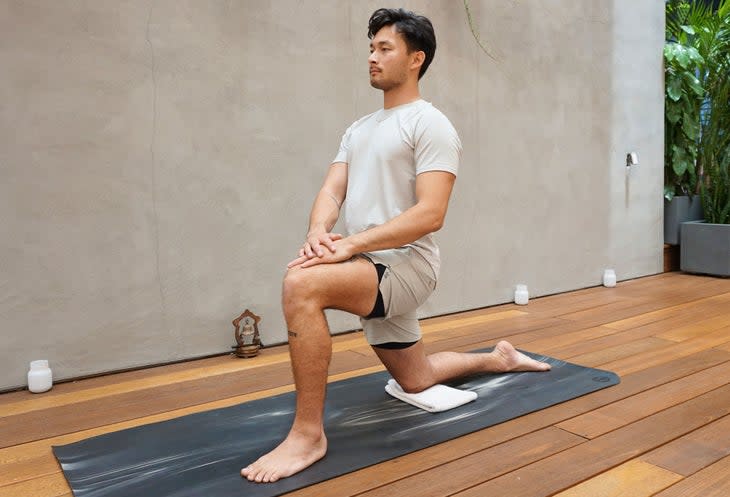
Anjaneyasana (Low Lunge)
How it helps: Men tend to have tighter hip flexors than women due to structural differences in the pelvic and hip anatomy. This tightness can trigger other issues, such as hamstring or quadricep injuries, which can then translate into back pain. This pose stretches the anterior hip muscles, including the hip flexors, which can help keep dads active in all seasons of life.
How to: Start from a Downward-Facing Dog Pose. Step your left foot forward and lower your right knee onto a blanket for cushioning. Stack your hands on your front quadricep or lift your arms alongside your ears. Shift your pelvis forward or backward slightly, to play with the stretch and potentially deepen the opening of the right hip flexor. Stay here for 2-3 breaths.
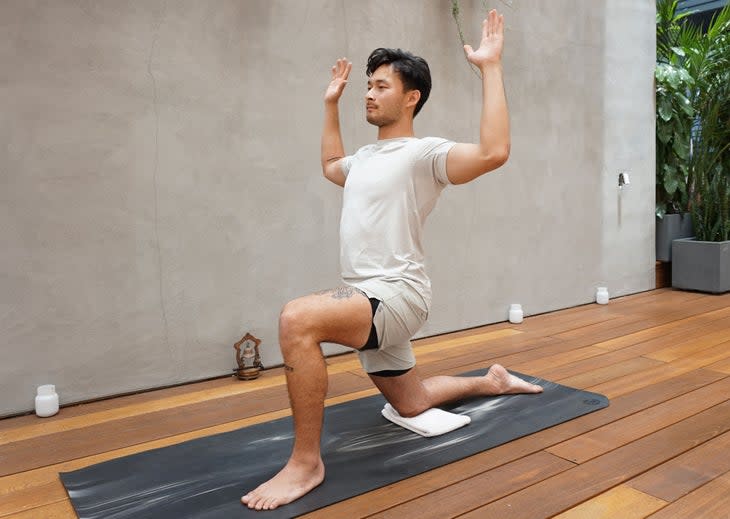
Low Lunge with Goal Post Arms
How it helps: The tighter the pectoralis muscles, the more the shoulders will hunch forward. This chest stretch is the perfect stretch for tight pecs and simultaneously strengthens the upper back muscles.
How to: From Low Lunge, bend your elbows at shoulder height, making the shape of a goal post or a cactus with your fingers pointed toward the ceiling. To open the chest further, lift your sternum and take a slight back bend, which deepens the stretch in the pectoralis muscles. Stay here for 2-3 breaths.
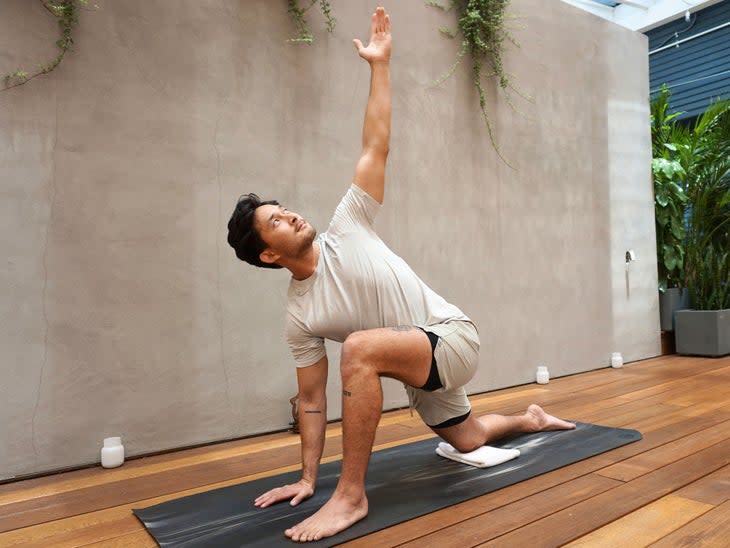
Low Lunge Twist
How it helps: Twisting is an important action we often take for granted. We twist to reach back to secure our seatbelts or even put on our jackets. Strong muscles around the lumbar spine and abdominal core help increase spinal stability so the dads in your life can swing their grandkids around.
How to: From Low Lunge, lower your left hand to the mat beneath your right shoulder. Place your left hand on your left thigh for leverage and support or reach it up toward the ceiling. Twist your sternum towards your left thigh to target the spinal muscles. The back knee can remain on the ground or you can lift it off the mat to deepen the spinal twist. Stay here for 2-3 breaths.
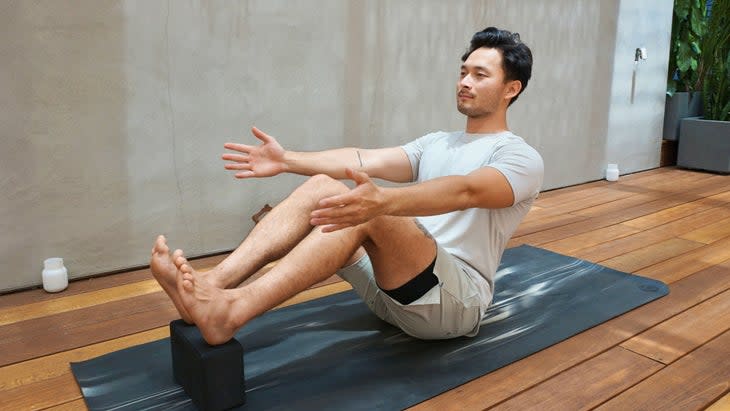
Navasana (Boat Pose)
How it helps: A strong core helps to support the low back and keep the spine healthy. Navasana is a great pose for core (and hip flexor) strengthening, and also encourages upright spinal alignment and chest opening.
How to: From Low Lunge, step your right foot forward next to your left foot. Then lower yourself to a seat. Lean your torso back as you lift your feet off the ground, balancing on your sacrum. Keep your knees bent initially. If you want, consider straightening the legs. If you feel a strain in your lower back, rest your heels on a block to soften the work of the hips. Draw your navel toward your spine, focusing on the engagement of the abdominal muscles. Stay here for 3 breaths.
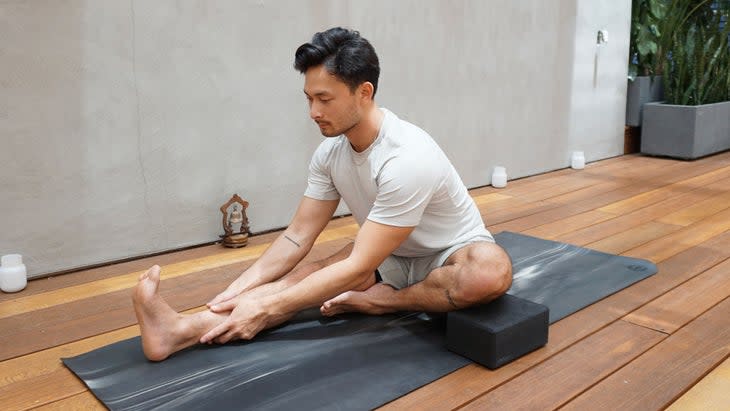
Janu Sirsasana (Head-to-Knee Forward Bend)
How it helps: From picking us up when we were babies to running with us at the sidelines of our sports activities, dads use their hamstrings a lot. Tight hamstrings can leave us prone to injury in our hips and knees. Forward bends not only stretch the hamstrings, bringing relief to the back of the legs, but also allow us to relax the nervous system. This stretch also offers a little side stretch, as it emphasizes the elongation of the bent-knee side of the body.
How to: From Boat Pose, lower your feet and bend your left knee so your foot presses into your right inner thigh. Turn your chest slightly to square yourself with your right foot and start to lean your chest forward in the direction of your right leg. Stay here for 3-5 breaths. With every inhalation, lengthen your back, and with every exhalation, allow yourself to release and, perhaps, fold deeper.
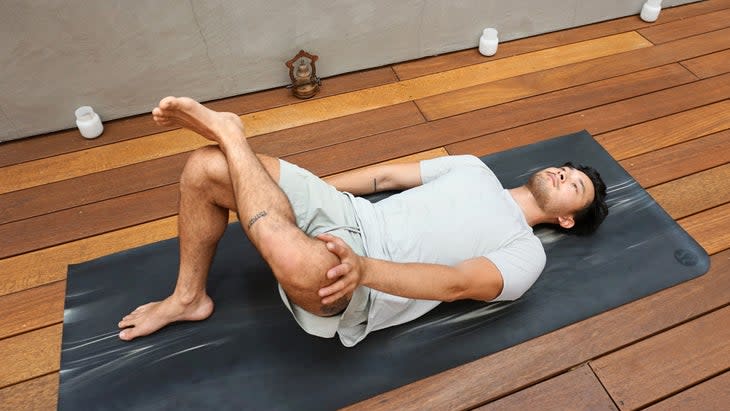
Reclining Pigeon
How it helps: The gluteus and outer hip muscles are some of the most powerful muscles in our body, and as a result, they take a lot of load when we exercise our bodies. Men tend to have inflexible hips due to their intrinsic anatomy, and the back and outer hips consequently need some loving care. Stretching the outer hips is important to counteract the tightness in the gluteal muscles, which decreases the risk of hip injury.
How to: From Head-to-Knee Forward Bend, roll onto your back and stack your left ankle above your right knee into a "figure four" shape. Dorsiflex your left foot and gently press your left thigh away from you. Keep your lower back, left foot, and sacrum relaxed on the floor. Stay here for 3-5 breaths.
Make your way back into Adho Mukha Svanasana (Downward-Facing Dog Pose) and practice the above poses on your other side.
Follow along with the video, which moves through the sequence smoothly, holding one breath per movement.
For exclusive access to all of our fitness, gear, adventure, and travel stories, plus discounts on trips, events, and gear, sign up for Outside+ today.

